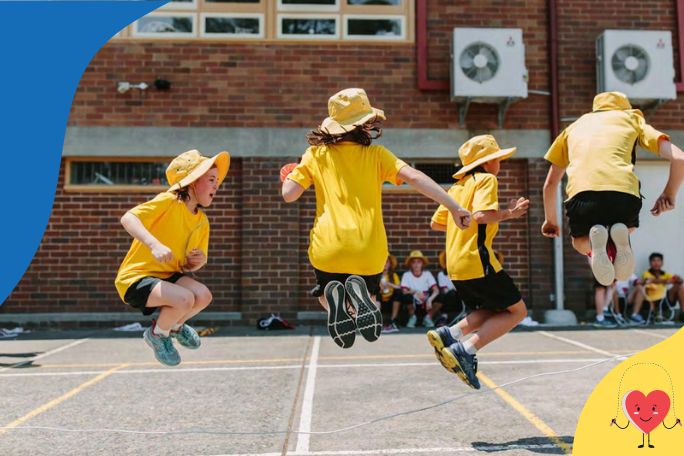Lesson summary
How do you determine the best length for a skipping rope? What distance should long rope swingers stand apart from each other? What surfaces are best for skipping? We could tell you the answers, but good scientific minds are always seeking evidence to support their claims. So in this lesson, students make a hypothesis, conduct scientific experiments, and present their findings visually, to answer these questions and more.
Learning intentions:
Students will...
- use the scientific method to predict, gather, analyse, evaluate and present data
- use positive social skills to explain their reasoning to their peers, with justification.
Success criteria:
Students can...
- perform a variety of movement skills
- compare and contrast different skipping techniques
- discuss and build upon the ideas of others
- use a table and column graph to collect and present data visually.
Lesson guides and printables
Lesson details
Curriculum mapping
Australian Curriculum content descriptions:
Year 3 & 4 Health and Physical Education:
- Practise and refine fundamental movement skills in a variety of movement sequences and situations (ACPMP043)
Year 3 Science:
- With guidance, identify questions in familiar contexts that can be investigated scientifically and make predictions based on prior knowledge (ACSIS053)
- With guidance, plan and conduct scientific investigations to find answers to questions, considering the safe use of appropriate materials and equipment (ACSIS054)
- Consider the elements of fair tests and use formal measurements and digital technologies as appropriate, to make and record observations accurately (ACSIS055)
- Use a range of methods including tables and simple column graphs to represent data and to identify patterns and trends (ACSIS057)
- Compare results with predictions, suggesting possible reasons for findings (ACSIS215)
- Reflect on investigations, including whether a test was fair or not (ACSIS058)
Year 4 Science:
- With guidance, identify questions in familiar contexts that can be investigated scientifically and make predictions based on prior knowledge (ACSIS064)
- With guidance, plan and conduct scientific investigations to find answers to questions, considering the safe use of appropriate materials and equipment (ACSIS065)
- Consider the elements of fair tests and use formal measurements and digital technologies as appropriate, to make and record observations accurately (ACSIS066)
- Use a range of methods including tables and simple column graphs to represent data and to identify patterns and trends (ACSIS068)
- Compare results with predictions, suggesting possible reasons for findings (ACSIS216)
- Reflect on investigations, including whether a test was fair or not (ACSIS069)
Syllabus outcomes: ST2-4WS, MOS2.4, GSS2.8, GYS2.10
General capabilities: Numeracy, Critical and Creative Thinking, Personal and Social Capability
Relevant parts of the Year 3 & 4 Health and Physical Education achievement standards: Students refine fundamental movement skills and apply movement concepts and strategies in a variety of physical activities and to solve movement challenges.
Relevant parts of the Year 3 Science achievement standards: Students use their experiences to identify questions and make predictions about scientific investigations. They follow procedures to collect and record observations and suggest possible reasons for their findings, based on patterns in their data. They describe how safety and fairness were considered and they use diagrams and other representations to communicate their ideas.
Relevant parts of the Year 4 Science achievement standards: Students follow instructions to identify investigable questions about familiar contexts and make predictions based on prior knowledge. They describe ways to conduct investigations and safely use equipment to make and record observations with accuracy. They use provided tables and column graphs to organise data and identify patterns. Students suggest explanations for observations and compare their findings with their predictions. They suggest reasons why a test was fair or not.
This lesson is part of the wider unit of work Jump Rope For Heart: Jump Investigators – Years 3 & 4
Time required: 55 mins
Level of teacher scaffolding: Low – facilitate whole class discussions and support students in conducting experiments and recording data.
Resources required
- Device capable of presenting a video to the class
- Experiment Record Sheet – one copy per student
- Measuring tape – one per group
- Skipping ropes – short and long – one each per group
- Stopwatch – one per group
Skills
This lesson is designed to build students’ competencies in the following skills:
- Communication
- Critical thinking
- Problem solving
- Social skills
- Collaboration
Additional info
The Heart Foundation’s ready-made skipping program, Jump Rope for Heart, helps primary school students move more and have fun, while they raise funds for heart research, patient support and programs that help save lives.


Welcome back!
Don't have an account yet?
Log in with:
By signing up to Cool.org you consent and agree to Cool's privacy policy to
store, manage and process your personal information. To read more, please see
our privacy policy here(Opens in new tab).
Create your free Cool.org account.
Many of our resources are free, with an option to upgrade to Cool+ for premium content.
Already have an account?
Sign up with:
By signing up to Cool.org you consent and agree to Cool's privacy policy to
store, manage and process your personal information. To read more, please see
our privacy policy here(Opens in new tab).